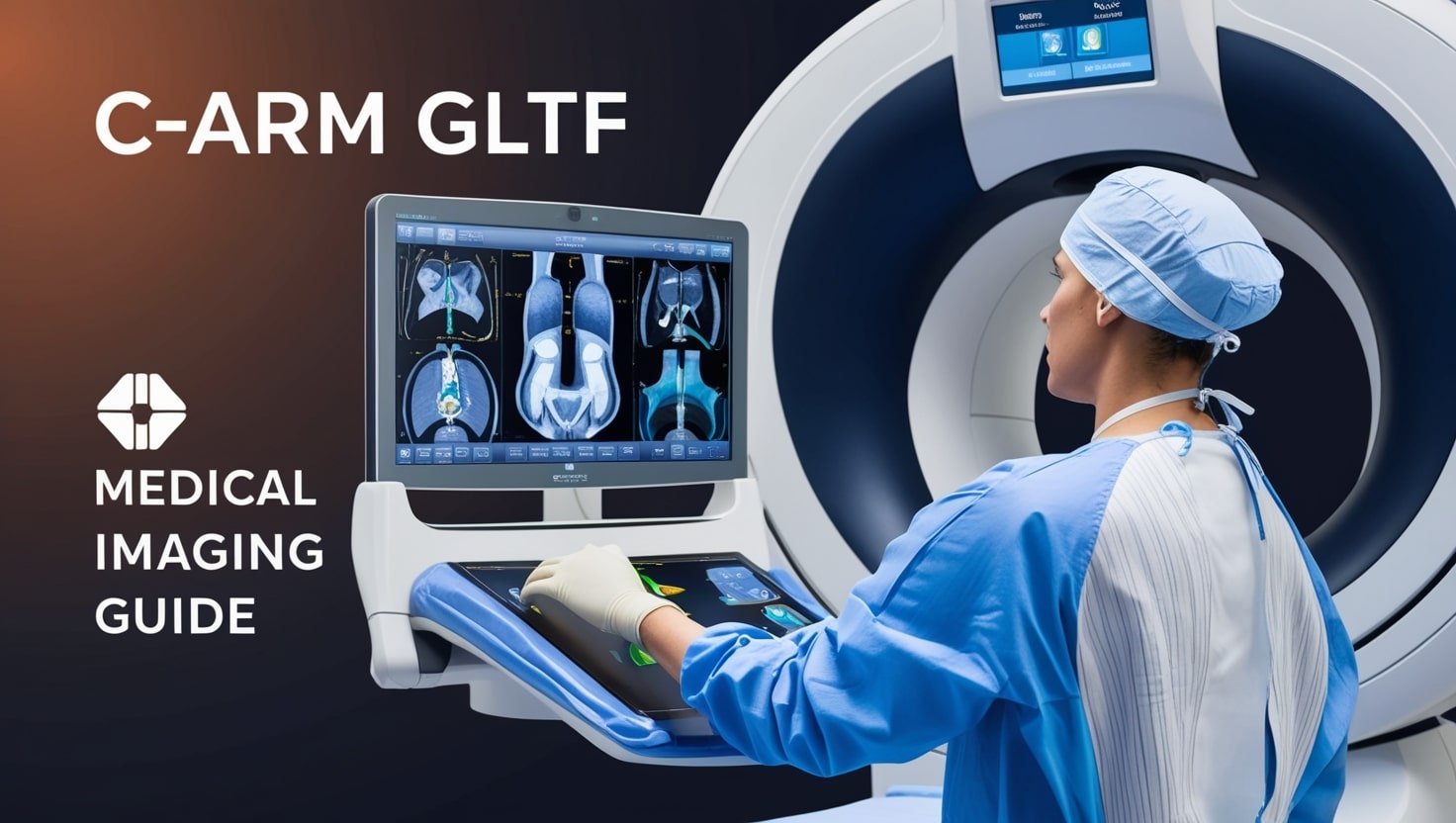Introduction to C-Arm GLTF
C-arm GLTF (Graphics Library Transmission Format) is revolutionizing how medical imaging is processed and transmitted. C-arm devices, used extensively in radiology and surgery, allow for precise imaging during complex procedures. Integrating GLTF technology into these devices enhances real-time 3D data visualization, improving accuracy and efficiency in medical diagnostics. This article explores the significance of C-arm GLTF, its impact on healthcare, and how it is changing the medical imaging landscape.
The Importance of Real-Time Imaging in Healthcare
In healthcare, speed and accuracy in imaging are crucial. C-arm GLTF technology facilitates real-time visualization, allowing doctors and surgeons to make swift decisions. By converting 2D images into detailed 3D models, C-arm GLTF optimizes the process, providing a clearer picture of the patient’s anatomy. This capability is especially vital during surgeries that require precise movements, such as spinal or orthopaedic procedures.
How C-Arm GLTF Improves Workflow in Operating Rooms
One of the critical benefits of C-arm GLTF is its ability to streamline workflows in the operating room. Traditional imaging systems often require time-consuming setups and processing, but C-arm GLTF eliminates much of this delay by providing instant access to high-quality 3D images. Surgeons can now perform complex procedures with minimal disruption, as the technology ensures that vital imaging data is always available when needed.
The Impact of C-Arm GLTF on Patient Outcomes
C-arm GLTF directly influences patient outcomes by improving the accuracy of surgical procedures. With enhanced imaging capabilities, surgeons can make more informed decisions, minimizing the risk of complications. The 3D visualization provided by C-arm GLTF allows for better planning and execution of surgeries, leading to shorter recovery times and improved overall patient satisfaction.
The Role of C-Arm GLTF in Minimally Invasive Surgeries
Minimally invasive surgeries rely heavily on accurate imaging to guide instruments within the body. C-arm GLTF’s ability to provide clear, real-time 3D images makes it an essential tool in such procedures. By delivering high-resolution images with reduced radiation exposure, C-arm GLTF enhances surgical precision and ensures the safety of patients and medical staff.
How C-Arm GLTF Enhances Radiation Safety
One of the significant concerns with medical imaging technologies is radiation exposure. C-arm GLTF addresses this issue by reducing the radiation required for high-quality imaging. The technology’s efficiency in transmitting and rendering images means fewer X-rays are needed, making the process safer for patients undergoing multiple scans.
C-Arm GLTF and 3D Image Quality
The quality of 3D images produced by C-arm GLTF is unparalleled in the medical field. Traditional 2D imaging can sometimes lead to misinterpretations or missed details, but C-arm GLTF offers an immersive 3D experience that ensures every aspect of the anatomy is captured. This improved image quality leads to better diagnostics and more successful treatment plans.
Adoption of C-Arm GLTF in Various Medical Specialties
C-arm GLTF is being rapidly adopted across various medical specialities, including orthopaedics, cardiology, and neurology. The technology’s ability to provide real-time, detailed 3D imaging significantly enhances procedural accuracy in these fields. Surgeons can now visualize complex structures such as blood vessels or bones with unprecedented clarity, leading to better surgical outcomes.
The Future of Medical Imaging with C-Arm GLTF
As technology continues to evolve, the future of medical imaging looks promising, with C-arm GLTF at the forefront. With ongoing artificial intelligence and machine learning developments, C-arm GLTF is expected to become even more integrated into automated diagnostic systems. This innovation will enable faster diagnoses, personalized treatment plans, and a more
streamlined healthcare system.
Comparing C-Arm GLTF with Traditional Imaging Methods
When comparing C-arm GLTF to traditional imaging methods, the advantages become apparent. While older technologies are often limited by their 2D nature and slow processing speeds, C-arm GLTF offers fast, accurate 3D imaging that is immediately accessible. This modern approach eliminates many inefficiencies associated with traditional imaging, providing a more reliable solution for today’s demanding medical environments.
C-Arm GLTF in Spinal Surgery
Spinal surgery demands high precision, involving delicate structures such as the spinal cord and nerves. C-arm GLTF enhances the accuracy of these procedures by offering surgeons a real-time 3D view of the spine. This allows for more precise placement of screws, rods, or implants, minimizing the risk of nerve damage. The improved visualization provided by C-arm GLTF helps reduce surgical complications and accelerates patient recovery, making it an invaluable tool in spinal healthcare.
The Benefits of C-Arm GLTF for Radiologists
Radiologists benefit greatly from C-arm GLTF as it simplifies the interpretation of complex images. By providing explicit, detailed 3D models, radiologists can make faster, more accurate diagnoses. The technology also reduces the need for multiple scans, as the high-quality images produced by C-arm GLTF are often sufficient on the first attempt.
C-Arm GLTF’s Role in Research and Development
C-arm GLTF is enhancing clinical practice and contributing to research and development in medical imaging. Its ability to create detailed 3D visualizations has opened up new possibilities for studying anatomical structures and disease progression. Researchers can use C-arm GLTF to test new surgical techniques, develop innovative medical devices, and improve diagnostic methods. As the technology evolves, it will continue to drive advancements in medical research and clinical care, shaping the future of healthcare.
Enhancing Minimally Invasive Surgery with C-Arm GLTF
Minimally invasive surgeries rely on advanced imaging to guide instruments through small incisions. C-arm GLTF’s real-time 3D imaging ensures surgeons can perform these procedures more precisely. By providing a clear view of internal structures, this technology helps reduce the risks associated with blind navigation. Patients benefit from shorter recovery times, reduced scarring, and fewer complications, making C-arm GLTF a critical tool in modern medicine’s rise in minimally invasive techniques.
Cost-Efficiency and C-Arm GLTF Technology
C-arm GLTF not only improves medical outcomes but also offers cost-efficiency. Hospitals can lower operational costs by streamlining the imaging process and reducing the need for repeat scans. The reduced radiation exposure and faster image processing also contribute to shorter patient stays and less time spent in recovery, ultimately saving time and Money.
Conclusion: C-Arm GLTF as a Game-Changer in Medical Imaging
C-arm GLTF represents a significant advancement in medical imaging, providing real-time, high-quality 3D images that enhance the accuracy of diagnostics and surgical procedures. Its impact on patient care, workflow efficiency, and radiation safety cannot be overstated. As healthcare continues to embrace technology, C-arm GLTF stands out as a vital tool that will shape the future of medical imaging for years to come.


